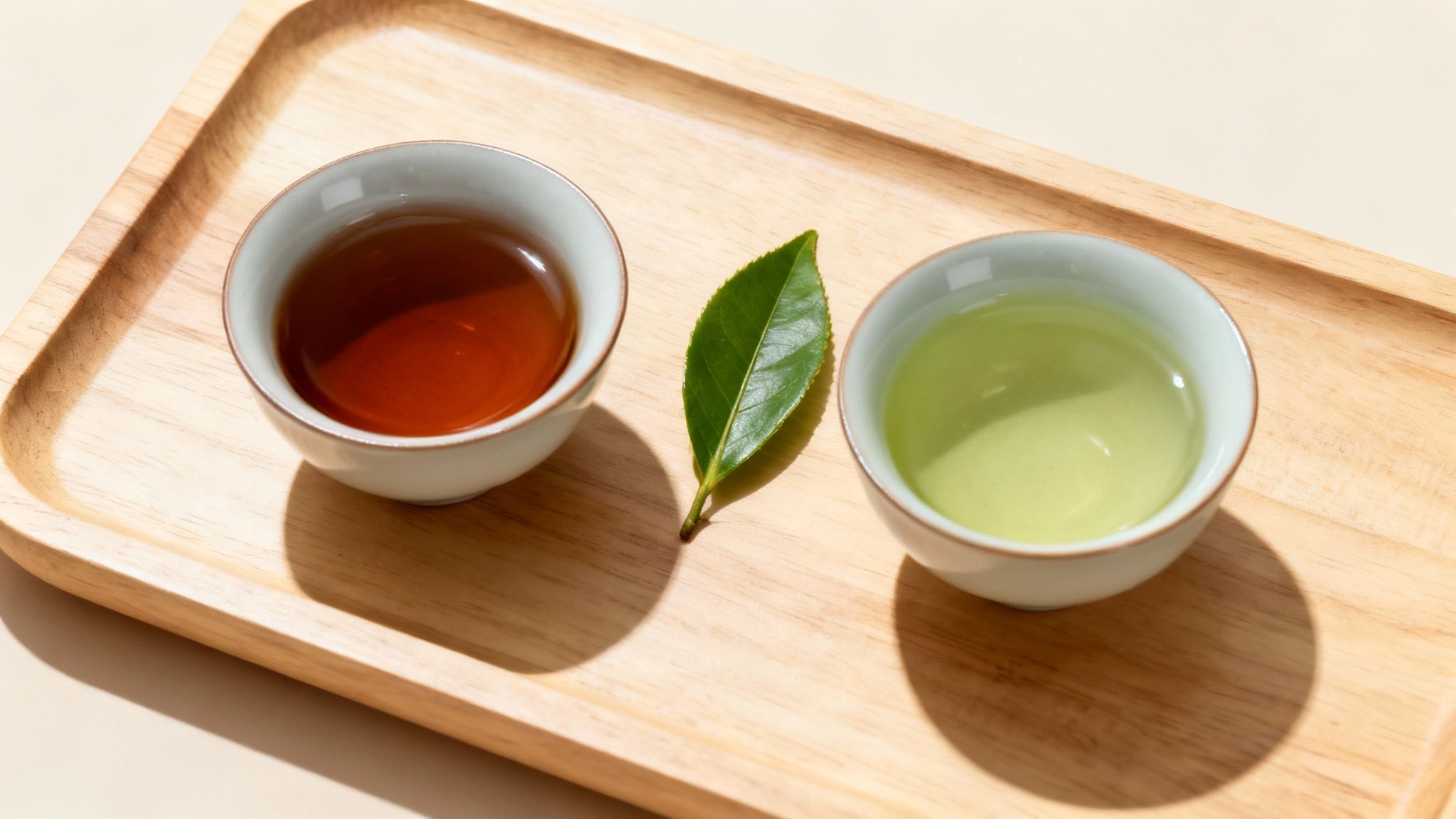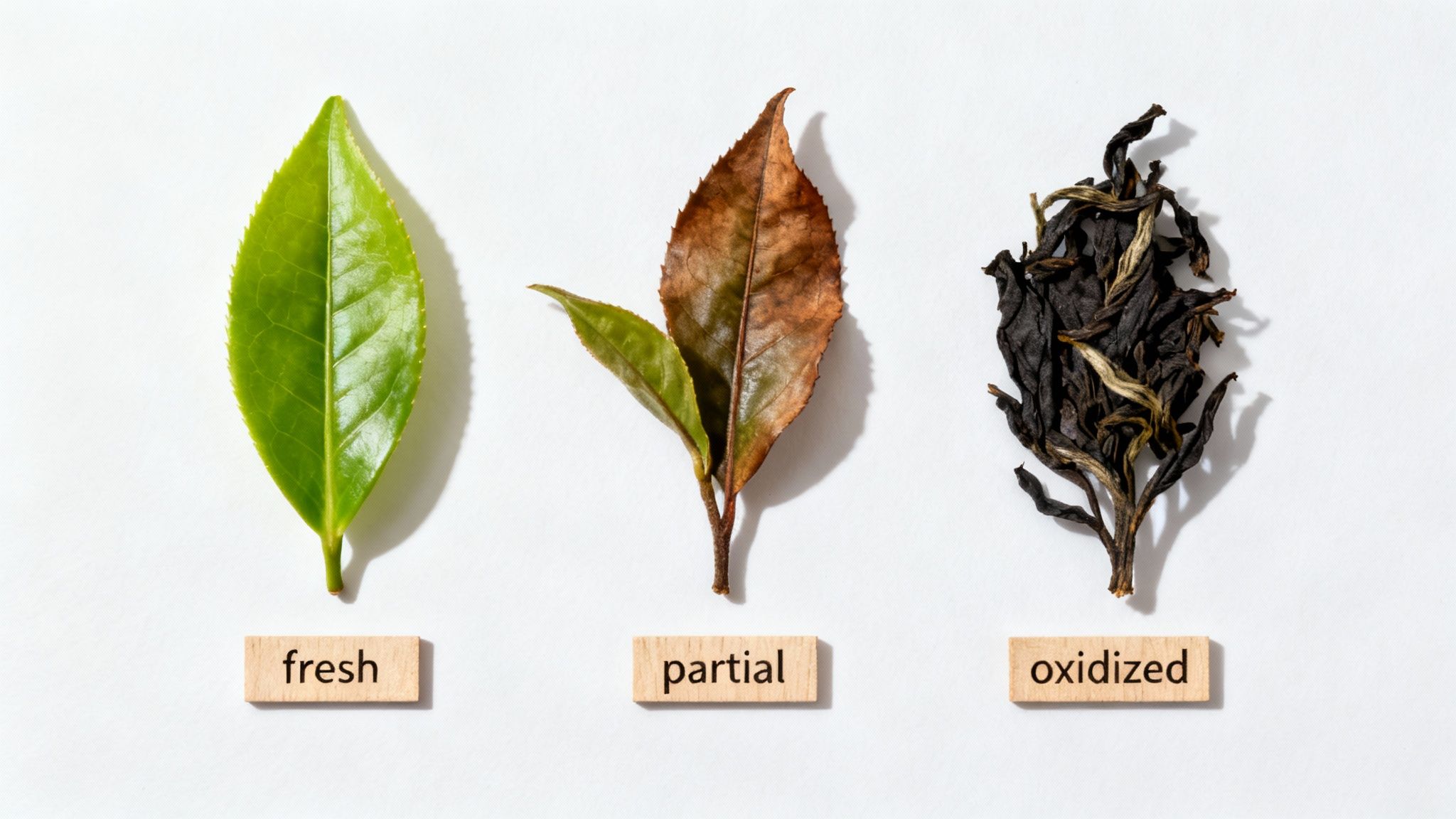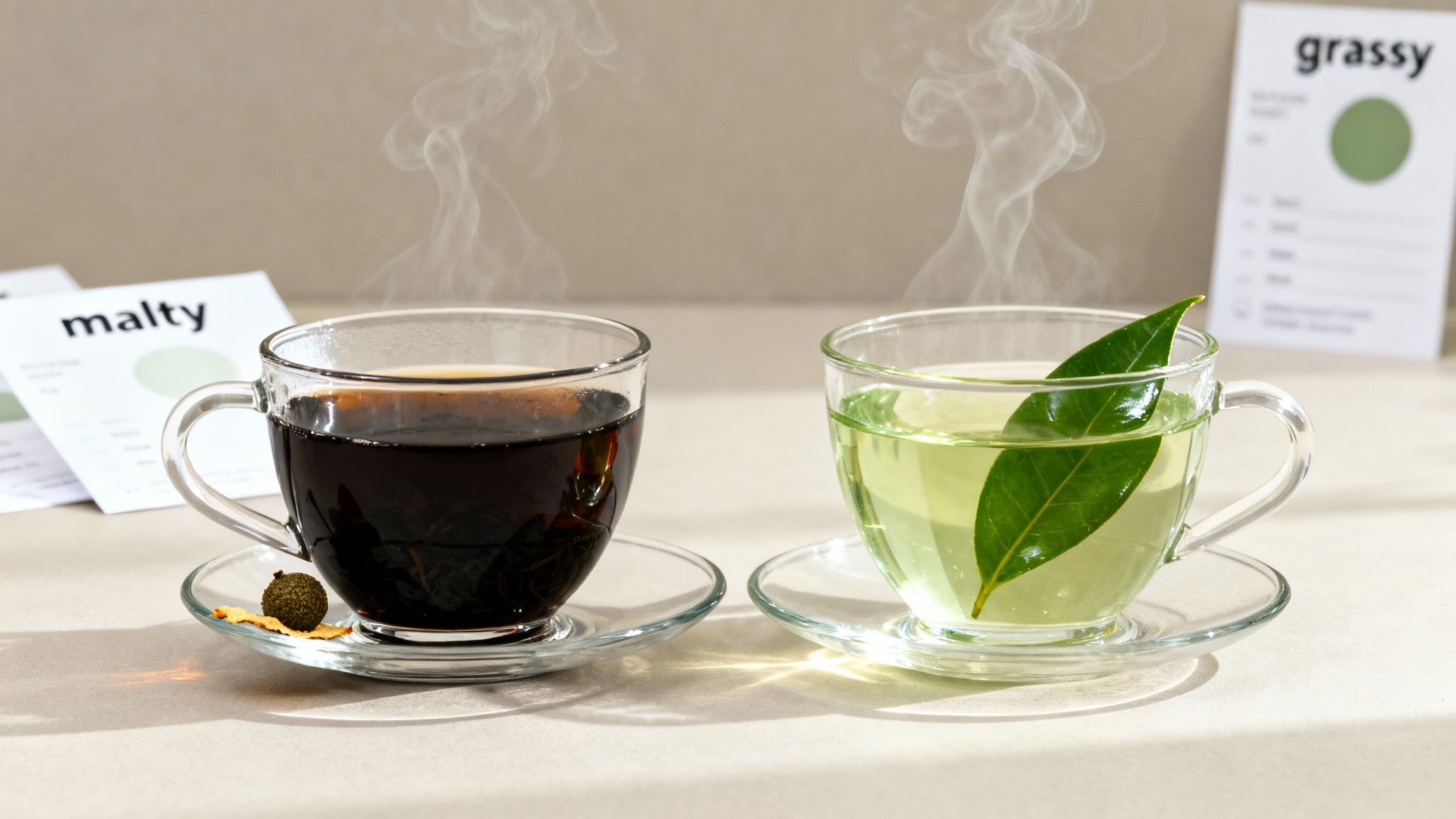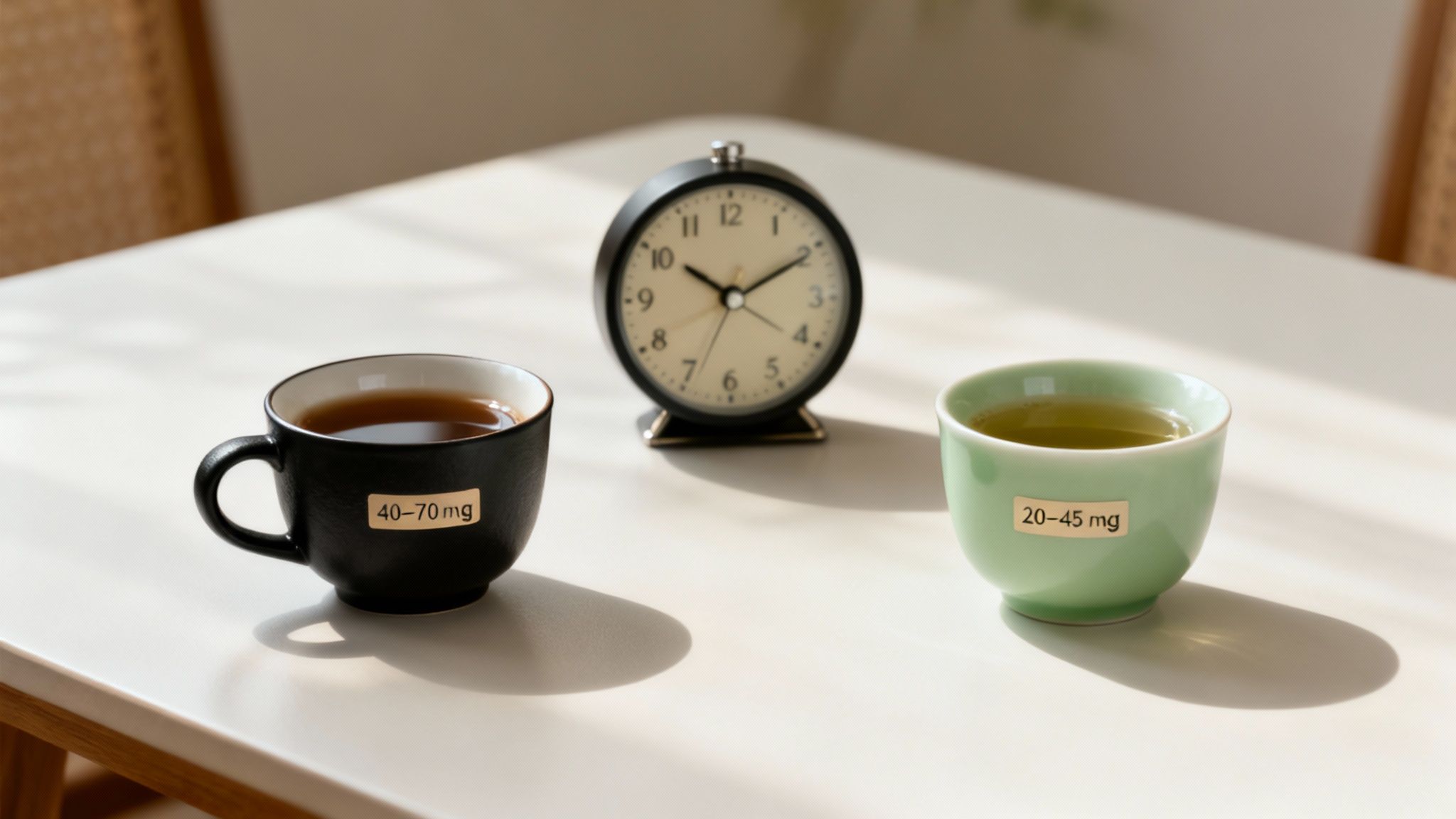When you get right down to it, the great debate between black and green tea boils down to a single, critical step in their making: oxidation. Black tea is given the full treatment, allowing it to fully oxidise, which is what develops its deep, dark colour and robust flavour. Green tea, on the other hand, is unoxidised, a process that locks in its fresh, delicate and more grassy character. It all comes down to whether you're after a bold, malty brew or a light, vibrant one.
A Tale of Two Teas From One Plant

It always surprises people to learn that both black and green tea come from the very same plant, Camellia sinensis. Because they share a single origin, their leaves start out with a near-identical chemical makeup. The dramatic differences we see, smell, and taste in the final cup have nothing to do with the plant itself, but everything to do with how the leaves are handled after they're plucked.
The journey from leaf to cup is a masterclass in craft. Every decision the tea maker makes—from withering and rolling to the final drying—shapes the personality of the tea. Grasping these subtle yet profound distinctions is the key to appreciating how one humble plant can give us such an incredible spectrum of flavours. If you're curious about the wider world of infusions, you can explore the main types of tea in our detailed guide.
Here in the UK, there's a clear winner in this tale. Black tea has long been the backbone of British tea culture. A recent study found that a whopping 71% of British consumers still reach for a traditional black tea for their daily cuppa, a preference that's holding steady across all generations. You can dive into more findings from the 2025 UK Tea and Infusions Census Study on worldteanews.com.
The whole story is in the oxidation. It’s a natural enzymatic process—think of an apple browning after you slice it. This is deliberately encouraged for black tea but stopped almost immediately for green tea, creating two completely different sensory experiences from the same leaf.
To get us started on this deep dive, let's lay out the fundamental differences in a quick, at-a-glance comparison.
Key Differences Between Black and Green Tea
This table captures the essence of what sets these two teas apart. It's a simple summary, but it highlights the core contrasts that we'll be exploring in more detail.
| Attribute | Black Tea | Green Tea |
|---|---|---|
| Processing | Fully oxidised | Unoxidised (pan-fired or steamed) |
| Flavour Profile | Bold, malty, full-bodied, robust | Light, grassy, vegetal, fresh |
| Colour | Dark amber to deep red | Pale green to light yellow |
| Caffeine | Higher (40-70mg per cup) | Lower (20-45mg per cup) |
As you can see, the path each tea takes after harvesting leads to a vastly different destination in your cup. Now, let's get into the nitty-gritty of each of these attributes.
How Processing Creates Two Different Teas

The real heart of the black vs. green tea debate isn't in the plant itself—they both spring from the very same Camellia sinensis bush. The magic, and the vast difference in your cup, happens entirely in what the tea maker does after the leaves are picked. It all comes down to a single, crucial process: oxidation.
Think of oxidation as what happens when you slice an apple and leave it on the counter. The flesh starts to brown as enzymes in the fruit react with the air. It’s a natural reaction that begins the second a tea leaf is plucked, changing its chemistry, colour, and flavour. For black tea, this process is encouraged and carefully controlled. For green tea, it’s stopped dead in its tracks.
The Path of Black Tea: Full Oxidation
To get that bold, full-bodied brew we all know, black tea leaves are taken on a deliberate journey to maximise oxidation. This isn't just a simple drying process; it's a methodical craft that builds the deep, malty character and gives the tea its signature dark amber liquor.
It’s a four-stage affair:
- Withering: First, the fresh leaves are laid out to wilt, which can reduce their water content by up to 30%. This step is essential to make them soft and supple enough for what comes next.
- Rolling: The now-pliable leaves are rolled, twisted, or sometimes crushed. This breaks the cell walls inside the leaf, releasing the enzymes that really get the oxidation going.
- Oxidation: Now for the main event. The leaves are spread out in a cool, humid room for several hours. As the enzymes mingle with oxygen, the leaves transform from green to a rich, coppery brown, all while developing wonderfully complex aromas.
- Drying: Finally, the leaves are fired in ovens. This blast of heat stops the oxidation process completely, locking in that classic black tea flavour profile.
This complete oxidation is what creates theaflavins and thearubigins, the compounds that give black tea its brisk flavour and reddish hue. It's a true transformation, building layer upon layer of complexity.
The Green Tea Method: Halting Oxidation
Green tea production is a world away. Here, the entire goal is to preserve the leaf’s natural, vibrant character—as if it were just plucked from the garden. To do this, tea artisans have to stop oxidation before it even has a chance to start. The secret? Applying heat right after the harvest.
There are two main ways they go about this:
- Pan-Firing: This is a technique you’ll see all over China. The leaves are gently heated in massive woks, which imparts a lovely toasty, almost nutty flavour to the finished tea.
- Steaming: Perfected in Japan, this method involves giving the leaves a quick blast of steam. This results in a much brighter, more vegetal, and sometimes oceanic flavour profile.
Once heated, the leaves are simply rolled and dried. By neutralising the oxidative enzymes from the get-go, this craft preserves the high levels of catechins and the brilliant green colour of the leaf. It's this fundamental split in the road that allows one plant to offer two completely different sensory journeys.
Comparing the Flavour and Aroma Profiles

This is where the real personality of a tea comes out. While both black and green teas start life on the very same plant, the way they are processed creates two completely different experiences in the cup. Getting to know these profiles is the first step to finding your perfect brew.
Black tea, having been fully oxidised, delivers a profile that’s generally bold, full-bodied, and robust. You’ll often find a comforting malty sweetness, sometimes with hints of honey, fruit, or even a touch of smoke. Just think of a classic English Breakfast—it’s strong, brisk, and built to stand up to a splash of milk and a bit of sugar. It’s the ideal morning companion for a reason.
The deep, complex notes in black tea are a direct result of theaflavins and thearubigins, compounds that develop during oxidation. These are responsible for both the reddish-brown colour and that characteristic brisk, malty taste that defines a proper cuppa.
But the world of black tea is anything but one-dimensional. An Assam from India will give you rich, malty notes, whereas a Ceylon from Sri Lanka can be surprisingly bright and citrusy. Then you have infused blends like Earl Grey, which brings the fragrant, floral aroma of bergamot into the mix, adding another layer of complexity. If you fancy diving deeper, our guide to black tea varieties is a great place to start.
The Fresh Spectrum of Green Tea
Green tea, by complete contrast, offers a flavour profile that’s much lighter, fresher, and more delicate. Because oxidation is stopped early on, it holds onto the natural, vegetal character of the fresh leaf. This leads to an incredible spectrum of tastes, shaped heavily by where it was grown and how it was made.
Japanese green teas, like Sencha, are steamed to halt oxidation. This process gives them a distinctly grassy, sometimes oceanic or umami flavour. They are vibrant and incredibly refreshing, perfect for an afternoon pick-me-up.
On the other hand, Chinese green teas are often pan-fired, a technique that coaxes out a gentler, nuttier, or slightly toasted quality. A classic Dragon Well (Longjing), for instance, is known for its smooth, mellow body and a sweet, almost chestnut-like finish.
Here’s a quick look at the kind of flavour notes you might come across:
- Black Tea Profiles: Malty, smoky, fruity, caramel, honey, leather, earthy, brisk.
- Green Tea Profiles: Grassy, vegetal, nutty, sweet, oceanic, buttery, floral, crisp.
Ultimately, the choice between black and green tea really just comes down to personal taste. Are you after a rich, powerful brew to kickstart your day, or a light, nuanced cup for a moment of quiet reflection? The best way to find out is to explore both worlds and see what truly delights your senses.
Comparing Health and Wellness Benefits
When it comes to the health benefits of black versus green tea, there's no simple winner. Instead, it’s about understanding their unique strengths, which come directly from how they're processed. Each one offers a distinct profile of compounds that can support your well-being in different ways.
Green tea is rightly famous for its high concentration of powerful antioxidants called catechins. Because the leaves are unoxidised, they hold onto a huge amount of these compounds, particularly epigallocatechin gallate (EGCG). This is the superstar catechin, widely studied for its potential to support metabolic health and protect cells from oxidative damage.
Black tea, having been fully oxidised, is a different story. The oxidation process transforms those catechins into more complex compounds: theaflavins and thearubigins. These are what give black tea its deep colour and robust flavour, but they also bring their own set of wellness advantages, especially for heart and gut health.
Green Tea: The Antioxidant Powerhouse
If your main goal is to load up on antioxidants, green tea is a fantastic choice. Its minimal processing means it keeps a rich profile of polyphenols that are believed to help combat cellular damage.
You can think of it like choosing a fresh, raw vegetable over a cooked one to get the most of certain nutrients. By stopping oxidation early, tea producers lock in these delicate compounds, making green tea the go-to for anyone after a fresh, vibrant boost.
Choosing green tea is like prioritising a direct infusion of the plant's natural protective compounds. Its high EGCG content makes it a popular choice for those focused on metabolic support and cellular health.
Black Tea: For Heart and Gut Harmony
For those looking to support their cardiovascular and digestive wellness, black tea has some compelling benefits. The theaflavins created during oxidation are well-researched for their role in helping to maintain healthy cholesterol levels and promoting good circulation.
What's more, the compounds in black tea can act as a prebiotic, feeding the beneficial bacteria in your gut. A healthy gut microbiome is the foundation of overall well-being, influencing everything from digestion to immunity. It's also worth remembering that different fermented drinks can have varied effects; for example, some people experience acid reflux from drinking kombucha.
Let's take a quick look at how the key compounds and benefits stack up side-by-side.
Comparing Key Compounds and Health Benefits
| Feature | Green Tea | Black Tea |
|---|---|---|
| Primary Antioxidants | Catechins, especially EGCG (Epigallocatechin Gallate). | Theaflavins and Thearubigins. |
| Key Health Focus | Cellular protection, metabolic support, and powerful antioxidant activity. | Heart health (cholesterol, circulation) and gut health (acts as a prebiotic). |
| Processing Impact | Minimal oxidation preserves the natural catechins found in the fresh tea leaf. | Full oxidation transforms catechins into more complex and robust compounds. |
| Best For… | Those seeking a fresh, potent source of plant-based antioxidants for overall wellness. | Individuals focusing on cardiovascular support and nurturing a healthy digestive system. |
This shift towards health-focused tea drinking is certainly being felt in the UK. While black tea is still the nation's classic brew, green tea is quickly gaining ground. A 2022 census found that 55% of UK tea drinkers now enjoy green tea at least occasionally, with younger generations in particular linking it to a healthier lifestyle. You can find more details in the full report on UK tea consumption habits.
Ultimately, your choice depends on what you're looking for. Are you after the powerful antioxidant hit from green tea's EGCG, or the heart and gut-friendly properties of black tea's theaflavins? Aligning your daily cuppa with your personal wellness goals is always the smartest approach.
Understanding the Caffeine Difference

The question of caffeine is almost always the first thing that comes up in the black vs green tea debate. And for good reason. It’s often the deciding factor in whether we reach for a cup to jolt us awake or one to gently wind down the day.
As a general rule of thumb, black tea packs a bigger punch. You can expect a standard cup to contain around 40-70 mg of caffeine, making it a reliable choice when you need a proper energy boost. Green tea is a bit more laid-back, usually coming in at a more modest 20-45 mg per cup, offering a much gentler lift.
But here’s the thing: those numbers are just a starting point. The final caffeine content in your cuppa is influenced by a whole host of factors, many of which are completely in your hands.
Factors That Influence Caffeine Levels
The type of tea is only part of the story. How much caffeine actually makes it from the leaf into your cup depends almost entirely on how you brew it.
Three key things come into play:
- Brewing Time: It’s simple, really. The longer the leaves sit in the water, the more caffeine they release. A black tea that’s been steeping for a full five minutes will be far more potent than one that’s only had a quick one-minute dip.
- Water Temperature: Hotter water is a master at extracting caffeine. Since black teas are typically brewed with boiling water and green teas with cooler water (to avoid bitterness), this naturally gives black tea a head start on the caffeine front.
- Leaf Varietal and Size: Just like with any plant, different cultivars of Camellia sinensis have different caffeine levels. On top of that, smaller, broken leaves—the kind you find in many tea bags—have a larger surface area and release their caffeine much faster than whole leaves.
It's not just about the amount of caffeine, but how your body processes it. Both teas contain L-theanine, an amino acid famous for creating a state of calm, alert focus. This clever compound partners with caffeine for a smoother, less jittery lift than you’d get from coffee.
The Role of L-theanine
The presence of L-theanine is what makes the caffeine hit from tea so unique. This amino acid essentially smooths out the sharp edges of the caffeine, preventing the sudden spikes and crashes you might get from other caffeinated drinks.
This means even a strong cup of black tea can deliver a sustained, focused energy, while a cup of green tea offers a gentle lift that sharpens your concentration without making you feel restless. Delving into the subtleties of the caffeine content in teas allows you to pick the perfect brew for any moment, whether you need a powerful start to your day or a quiet moment of focus.
So, Which Tea is For You?
Choosing between black and green tea isn't about crowning a winner. It's about picking the right brew for the right moment. The best cup is often decided by your mood, the time of day, or what you're hoping to get from your tea break.
Think of it like this: are you after a robust replacement for your morning coffee? A bold, malty Assam black tea is just the ticket. Its higher caffeine content is perfect for shaking off the cobwebs and getting you focused for the day ahead.
Matching Your Tea to Your Day
On the other hand, if you're looking for a gentle companion for a quiet afternoon or something to help with digestion after a big lunch, green tea is a brilliant choice. A cup of Japanese Sencha, with its fresh, grassy notes and lower caffeine, offers a refreshing lift that won't have you bouncing off the walls come bedtime.
To make it even simpler, here are a few classic scenarios:
- The Morning Kick-Start: Go for a classic English Breakfast or a rich Assam black tea. Their full body and brisk flavour are designed to wake you up.
- The Afternoon Pick-Me-Up: A delicate Sencha or a nutty Dragon Well green tea provides a gentle boost with a sense of calm, thanks to that L-theanine.
- Post-Meal Comfort: A light peppermint green tea blend is fantastic for settling the stomach and cleansing the palate.
- A Cosy Evening Brew: A decaffeinated black tea, like a fragrant Earl Grey, gives you all the comforting flavour without the caffeine kick.
The real question isn't "Which tea is better?" It's "Which tea is better for me, right now?" When you match your choice to your immediate need—whether it's energy, relaxation, or just a particular flavour—you really start to appreciate what each tea brings to the table.
Viewing your tea this way takes you beyond a simple comparison of facts and figures. It becomes a more personal, intuitive choice, ensuring you always have the perfect cup on hand to match any moment of your day.
A Few Final Questions
As you dive into the worlds of black and green tea, a few questions tend to pop up time and time again. Let’s clear those up so you can get on with enjoying your next brew.
Can I Drink Black and Green Tea Every Day?
Absolutely. For most of us, enjoying a few cups of both black and green tea each day is not only safe but can be a brilliant part of a healthy routine. The main thing to keep an eye on is caffeine.
A good rule of thumb is to stick to around 3-4 cups total per day. This way, you get all the goodness without interfering with things like your sleep.
Does Adding Milk to Black Tea Ruin the Benefits?
This is the big one, isn't it? There's been a lot of chat about this over the years. Some research suggests that a protein in milk called casein can latch onto the flavonoids in tea, making them a little less available for your body to absorb.
However, most studies show this effect is pretty minor. You're still getting a fantastic array of health benefits from your cuppa.
The consensus is simple: if you love your tea with a splash of milk, go for it. The benefits of drinking the tea far outweigh any tiny reduction in antioxidant power. A happy tea drinker is a healthy tea drinker.
Which Tea Is Better for Weight Loss?
If we're talking purely about metabolic impact, green tea often takes the top spot. It's packed with a specific catechin called EGCG, which is thought to give your metabolism a gentle nudge and help with fat oxidation.
But let's be realistic—both teas are fantastic, near-zero-calorie drinks. Swapping a sugary drink for a cup of black or green tea is always a win. The best tea for weight management is the one you enjoy enough to drink regularly as part of a balanced diet and active life.
Why Does My Green Tea Taste So Bitter?
Ah, the classic green tea problem. That sharp, bitter taste is almost never the fault of the tea leaves themselves—it’s all in the brewing. Nine times out of ten, it’s down to one of two things: your water is too hot, or you've let it steep for too long.
Green tea leaves are far more delicate than their black tea cousins. They need cooler water, somewhere around 75-85°C, and a much shorter brew time of just 1-3 minutes. Any more than that, and you start extracting too many tannins, which is what causes that unpleasant astringency. A little adjustment to your technique will reveal its true, delicate character.
At Jeeves & Jericho, we believe in the art of the perfect brew, from robust black teas to delicate green teas. Explore our ethically sourced, whole-leaf collections and find your new favourite today at https://www.jeevesandjericho.com.


